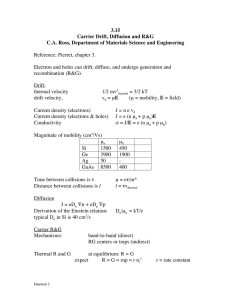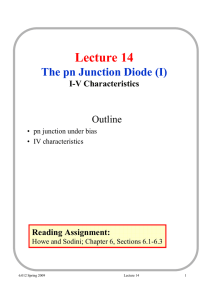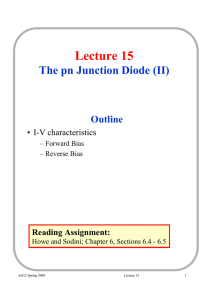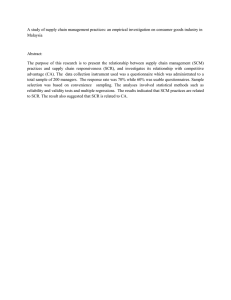Lecture 14
advertisement
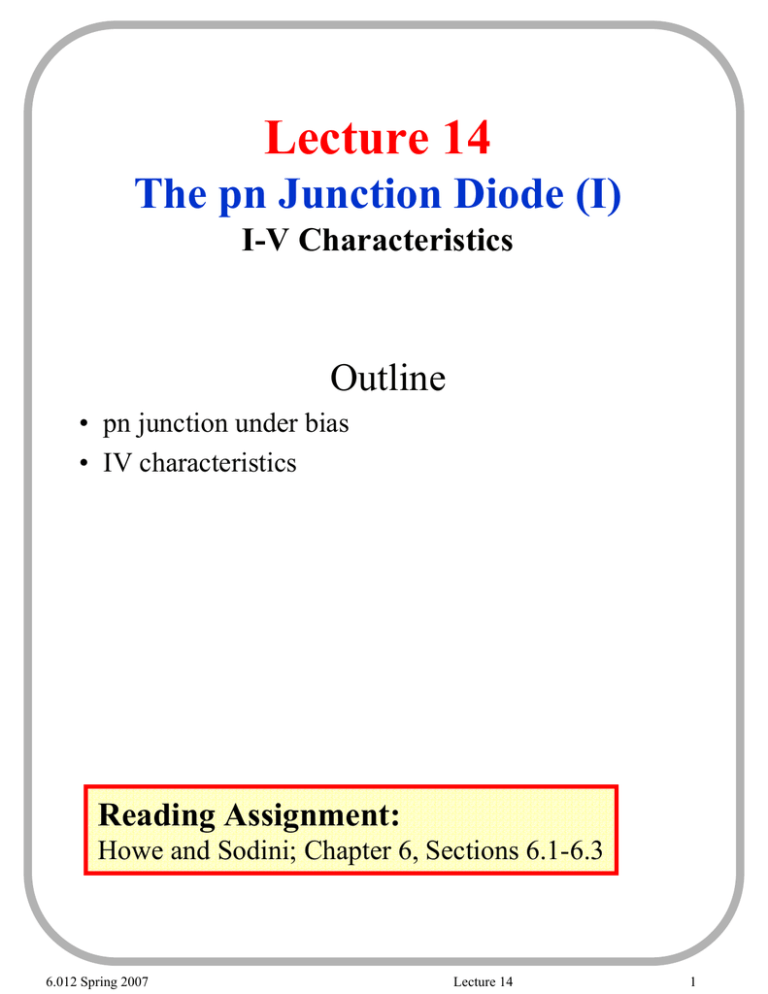
Lecture 14 The pn Junction Diode (I) I-V Characteristics Outline • pn junction under bias • IV characteristics Reading Assignment: Howe and Sodini; Chapter 6, Sections 6.1-6.3 6.012 Spring 2007 Lecture 14 1 1. PN junction under bias Focus on intrinsic region: p type n type x p type (a) (Na) metal contact to p side p x=0 x (Nd) n metal contact to n side (b) Upon application of voltage: • Electrostatics upset: – depletion region widens or shrinks • Current flows – With rectifying behavior • Carrier charge storage 6.012 Spring 2007 Lecture 14 2 I-V Characteristics ID (µA) 300 Forward Bias 200 Reverse Bias 100 VBD − 20 −19 −18 −0.25 0.25 0 0.50 0.75 VD (V) 800 VD (mV) −100 Breakdown −200 (a) ID(µA) (log scale) 103 100 10 slope 1 q kT 0.1 10−2 500 550 600 650 700 750 (b) To model I-V characteristics we need 2 concepts • The Law of the Junction • Steady-State Diffusion 6.012 Spring 2007 Lecture 14 3 Carrier Profiles: in thermal equilibrium ln po, no Na Nd po no ni2 Nd ni2 Na x 0 Jhdiff Jhdrift Jediff Jedrift In equilibrium: dynamic balance between drift and diffusion for electrons and holes inside SCR. Jdrift = J diff 6.012 Spring 2007 Lecture 14 4 Carrier Profiles: under forward bias For V>0, φB - V ↓ ⇒ |ESCR| ↓ ⇒ |Jdrift| ↓ ln p, n Na Nd po no p n ni2 Nd ni2 Na x 0 Jhdiff Jhdrift Jh Jediff Jedrift Je Current balance in SCR broken: Jdrift < Jdiff Net diffusion current in SCR ⇒ minority carrier injection into QNRs. Carrier flow can be high because lots of minority carriers are injected into QNRs from the majority side. 6.012 Spring 2007 Lecture 14 5 Carrier Profiles: under reverse bias For V<0, φB - V ↑ ⇒ |ESCR| ↑ ⇒ |Jdrift| ↑ ln p, n Na po Nd no ni2 Na ni2 Nd p n x 0 Jhdiff Jh Jhdrift Je Jediff Jedrift Current balance in SCR broken: Jdrift > Jdiff Net drift current in SCR ⇒ minority carrier extraction from QNRs. Carrier flow is small because there are few minority carriers extracted from QNRs from the minority side. 6.012 Spring 2007 Lecture 14 6 Minority Carrier Concentrations: in QNR What happens if minority carrier concentrations in QNR changed from equilibrium? ⇒ Balance between generation and recombination is broken • In thermal equilibrium: rate of break-up of Si-Si bonds balanced by rate of formation of bonds generation n o + po Si-Si bond recombination • If minority carrier injection: carrier concentration above equilibrium and recombination prevails Si-Si bond recombination n+p • If minority carrier extraction: carrier concentrations below equilibrium and generation prevails Si-Si bond 6.012 Spring 2007 generation n+p Lecture 14 7 Where does generation and recombination take place? 1. Semiconductor bulk 2. Semiconductor surfaces & contacts In modern silicon pn-junction devices, surface & contact recombination dominates because: • Prefect crystalline periodicity broken at the surface – ⇒ lots of generation and recombination centers; • Modern devices are small – ⇒ high surface area to volume ratio. Surfaces and contacts are very active generation and recombination centers ⇒ at contacts, carrier concentrations cannot deviate from equilibrium: In general, it is assumed that at contacts, the rate at which generation/recombination takes place is infinite. n(s) = n o ; 6.012 Spring 2007 p(s) = po Lecture 14 8 Complete physical picture for pn diode under bias: • In forward bias, injected minority carriers diffuse through QNR and recombine at semiconductor surface. ln p, n Na Nd po no p n ni2 Nd ni2 Na x 0 • In reverse bias, minority carriers generated at the semiconductor surface, diffuse through the QNR, and extracted by SCR. ln p, n Na po Nd no ni2 Na ni2 Nd p n x 0 6.012 Spring 2007 Lecture 14 9 What is the barrier (Bottleneck) to current flow? • Not generation or recombination at surfaces, • Not injection or extraction through SCR • But minority carrier diffusion through the QNRs Development of analytical current model: 1. Calculate the concentration of minority carriers at edges of SCR; 2. Find the spatial distribution of the minority carrier concentrations in each QNR; 3. Calculate minority carrier diffusion current at SCR edge. 4. Sum minority carrier electron and hole diffusion currents at SCR edge. 6.012 Spring 2007 Lecture 14 10 2. I-V Characteristics STEP 1: Computation of minority carrier boundary conditions at the edges of the SCR In thermal equilibrium in SCR, |Jdrift| = |Jdiff| • Define pno = ni2/Nd and npo = ni2/Na • Recall kT ⎜⎛ Na N d ⎟⎞ φB = ln ⎜ q ⎝ n i 2 ⎟⎠ • Rewrite ⎛N ⎞ ⎛ Na ⎞ d ⎟ and φ B = Vth ln⎜⎜ φ B = Vth ln⎜⎜ ⎟⎟ ⎟ ⎝ p no ⎠ ⎝ n po ⎠ • Solving for the equilibrium minority carrier concentrations in terms of the built-in potential, φB φB pno = N a e − Vth and n po = Nd e − Vth This result relates the minority carrier concentration on one side of the junction to the majority carrier concentration on the other side of the junction 6.012 Spring 2007 Lecture 14 11 p - p-QNR + n SCR n-QNR φ 0 -xp φB-V φB 0 xn x • The new potential barrier φj = (φB - VD) is substituted for the thermal equilibrium barrier to find the new minority carrier concentrations at the SCR edges. • Assume the detailed balance between drift and diffusion is not significantly perturbed. This says electrons are in equilibrium with each other across the junction. SAME for holes. −φ j −( φB −VD ) n p (−x p ) = Nd e Vth = N d e Vth and −φ j pn (x n ) = Na e Vth = N a e 6.012 Spring 2007 Lecture 14 −(φB −VD ) Vth 12 Law of the Junction [ ]e[ ]= n po e[ ] n p (−x p ) = Nd e and − φB Vth VD Vth VD Vth [ ]e[ ]= pno e[ ] pn (x n ) = Na e ni 2 where n po = Na − φB Vth and VD Vth VD Vth ni 2 pno = Nd • The minority carrier concentration at the SCR is an exponential function of applied bias. It changes one decade for every 60mV change in VD. • Law of the Junction is valid if minority carrier concentration is less than equilibrium majority concentration. This condition is called Low Level Injection. pn < nno and n p < p po 6.012 Spring 2007 Lecture 14 13 Voltage Dependence: • Forward bias (V>0): n p (−x p ) >> n po (−x po ) pn (x n ) >> pno (x no ) • Lots of carriers available for injection, the higher V, the higher the concentration of injected carriers ⇒ forward current can be high. • Minority carrier concentration is maintained at thermal equilibrium at the ohmic contacts. All excess carriers recombine at ohmic contact. n p(x) p n(x) (contact) (contact) (p-type) (n-type) p n(x n) n p(– x p ) -x p - Wp n p (– W p) = n p o 6.012 Spring 2007 xn Wn x p n(W n) = p no Lecture 14 14 • Reverse bias (V<0): n p (−x p ) << n po (−x po ) pn (x n ) << pno (x no ) Few carriers available for extraction ⇒ reverse current is small. There is limit in reverse bias to how low minority carrier concentrations at SCR edge can be: zero! Rectification property of the pn diode arises from minority-carrier boundary conditions at edges of SCR. (p-type) pn(x) np (x) (n-type) contact to p region contact to\ n region n p(– x p) = n po ⋅ e p n(x n) = p no ⋅ e << pno << npo np(-Wp)=npo - Wp 6.012 Spring 2007 V D ⁄ Vth -xp xn VD ⁄ Vth p n(W n) = p no Wn Lecture 14 x 15 What did we learn today? Summary of Key Concepts • Application of voltage to pn junction results in disruption of balance between drift and diffusion in SCR – In forward bias, minority carriers are injected into quasi-neutral regions – In reverse bias, minority carriers are extracted from the quasi-neutral regions • In forward bias, injected minority carriers recombine at the surface (contacts). • In reverse bias, extracted minority carriers are generated at the surface (contacts). • Computation of boundary conditions across SCR exploits quasi-equilibrium: balance between diffusion and drift in SCR disturbed very little • IV characteristics of p-n diode: Next Time ⎛ I = I o ⎜⎜ e ⎝ 6.012 Spring 2007 [] V Vth ⎞ −1⎟⎟ ⎠ Lecture 14 16
